Table of contents
- Scene: Portrait of Ferry Brouwer To ask!
- An eventful life
- The beginning of the success story
- Technicians for bold ideas
- Continuation of the success story: the entry into the helmet market
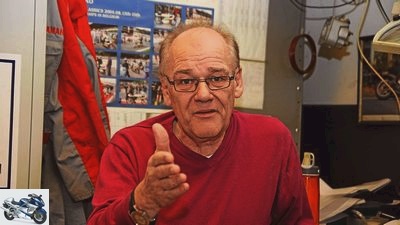
Siemer
Sports & scene
Scene: Portrait of Ferry Brouwer
Scene: Portrait of Ferry Brouwer
To ask!
Content of
He was a mechanic for greats like Phil Read and Jarno Saarinen. He brought Arai helmets to Europe and delighted tens of thousands with his Yamaha Classic Racing Team. But above all, Ferry Brouwer is a very curious boy.
Fred Siemer
02/20/2014
“Come on in ”, a friendly echo through the garden gate, Ferry Brouwer leads quickly past the extension of his wonderfully restored farmhouse, opens a double door and turns on the light. In his workshop – “Where else?” – he wants to report on his life. The seating available around a small desk reveals that people have often chatted here about god and the world, two and four bars, screws and mothers. Ferry points to a particularly small chair and says that once a week his five-year-old grandson can also have a say and that he regrets every week that this meeting is canceled due to other appointments.
Buy complete article
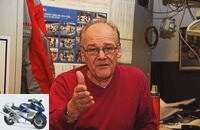
Scene: Portrait of Ferry Brouwer
To ask!
6 pages) as PDF
€ 2.00
Buy now
An eventful life
with Arai Helmet Europe, the Dutchman brought the Japanese first-class hats to us and became the “Arai-Man”. As the initiator of major street sport revivals and owner of the Yamaha Classic Racing Team, he has earned eternal fame in the classic scene. The Centennial TT in Assen 1998, when the former world champions competed with their legendary racers by the dozen, will not be forgotten. He also had a strong influence on the Bikers ‘Classics in Spa-Francorchamps, not least with his wonderful collection of perfectly groomed Yamaha racers, on which Steve Baker, Phil Read, Giacomo Agostini and many others were able to turn the short-stroke throttle again.
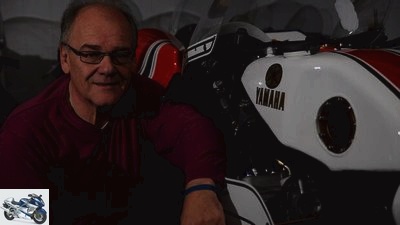
Siemer, Fred
Ferry Brouwer
A fantastic collection with up to 25 machines. “But that’s over,” smiles the 64-year-old. Even today, many cannot believe what they had to read at the beginning of last year: The Yamaha Classic Racing Team is going on a farewell tour. Is the man sick? Visibly no. So again:
Ferry, why did you stop in 2013?
“Because I really wanted to cut back when I was 65 at the latest, and I had planned to do that for a long time. I know a lot of fans are amazed. Yamaha was also amazed. But I think we’ve given the people – and the plant – something over the years. For me it was a full-time job in the end, Margriet, my wife, was also very involved, it was enough. “
Do you feel sad when you think about the beautiful collection?
“No, no, even racing bikes are nothing but things. I’m not a materialistic person so I can let go of things. Also: As a young man, I worked on leading racing motorcycles. Then I restored a lot of racing motorcycles and finally inspired so many people with this wonderful team. What more do I want? “
Listening to the grandchildren in the workshop, for example, or helping other children read at the granddaughter’s school. In any case, much better than arguing about entry fees with aging superstars. Contrary to what is often assumed, Ferry has always paid extra with the racing team. But not only he: “All mechanics worked in their free time without wages. They can’t do that forever either. They have families.”
What Ferry and his screwing friends have restored, rebuilt and cared for over the years is scattering to the wind. Among other things, the reproductions of the V4-125 and 250 go to Yamaha, “and that is like a gold medal for all of us: the work puts our work in a museum.”
The beginning of the success story
Ferry and Yamaha. A long story. He had accompanied his father since he was a child, when he looked after Dutch racers as a mechanic, and when he was six he saw his first TT in Assen in 1955. At the end of 1967 the two were in Zandvoort and happened to meet the Yamaha factory team there. Ferry told a Japanese who could speak some English about his passion for racing bikes. The Japanese was called Minoru Tanaka and invited him to Assen for the coming year. As always, Ferry smuggled into the paddock in 1968, Tanaka was delighted: “You can help us.”
Before the 19-year-old mechanic knew it, he was working on Phil Read’s motorcycle. The Briton not only won the Dutch TT, but later also the world title. On the Sunday after the race, Ferry was supposed to open the 125cc V4 engine and prepare everything for fun. “If the engine runs again immediately after installation, you can stay with us for the rest of the season,” Tanaka said, almost coolly. A test out of nowhere. Ferry insisted, the two became very good friends, their paths kept crossing.
How nervous were you back then in Assen?
“These engines were sacred to me. But I couldn’t afford shaky hands, I really wanted to take this chance. I soaked it all in, full of euphoria, and resigned from my employer, a good Opel dealer, on Monday. “
Phil Read won his third and fourth titles in 1968. How did he treat you?
“I know two Phils: very ambitious during the races, sometimes moody and strict. But privately he was almost fatherly to me for a long time, I lived with him and his wife for many months. Phil quickly noticed how deep my interest went and he let me do it. “
Still remarkable that he brought in such a young mechanic.
“Probably yes. At first I worked for him on the Yamaha team. But when he was a private driver, Phil hired me on his own initiative. I even went to some races during my military service. From my father, who worked for a lot of racers, I learned very early how meticulously and systematically you have to work on the racetrack. Phil probably liked that. “
Then why did you part anyway??
“1971 got off to a great start for us with three wins in four races. Before the fifth race at Spa, however, Phil had another mechanic remove the front fender without informing me. The man forgot to fix the brake hose, and Phil soon shot off the track. And made me responsible. I went there. “
Phil Read did not win another 250cc Grand Prix this season, but still took the title by a narrow margin. Meanwhile, Ferry signed on with Chas Mortimer, who then started next year for the Yamaha semi-works team with Saarinen, Sheene and Andersson, among others. “We have already received many factory parts there and had good contacts with the Japanese engineers. That’s why I always defend myself a little when it is said that Saarinen became world champion as a private driver.
Chas Mortimer also drove to the front with the two-cylinder 125 cc, which Ferry oversees. He even got by far the most points, but because only the best seven of thirteen results were counted, Angel Nieto was able to call himself world champion in the end.
How did you come to Jarno Saarinen in 1973??
“We worked closely with the plant in 1972, they could always keep an eye on us. I was really happy: Yamaha finally attacked in the premier class and I should be there. Against Ago. And against Phil, who had switched to MV. We started with two wins, unfortunately the chain broke in Hockenheim … “
…and then the cruel end in Monza. What was going on in you?
“You know, so much has been said and written about it, actually it would be in the interests of everyone involved at the time if we finally let this tragedy rest. Just so much: we lived very closely together back then, we mechanics and the drivers. So you’ve lost a friend too. But Bill Ivy was a friend too, and so were many others. Between the races, I was often out and about with Jarno and his wife Soili, we even went to see Versailles together. Yes, and drinking, I learned that from Jarno. He was a very positive, happy person. And absolutely professional on the racetrack. “
Technicians for bold ideas
Ferry Brouwer is still concerned with the Saarinen phenomenon today. He is looking for answers. On everything. Also when asked why the Finn is still so popular. Without a doubt, he had a lot of talent. “But others had that too. If I just think of his 1973 500 teammate, Hideo Kanaya. I think he was just as good as Jarno. ”Ferry has his own theory, and it has a lot to do with the attitude towards life in the early 1970s. “Back then, many were looking for adventure. And then there is the always sympathetically smiling racing driver Jarno Saarinen, who was simply able to appear much more relaxed than many others. And besides, with Soili he had a lovely wife who was always with him, except on the podium. The two as a couple, that went down well. For real.”
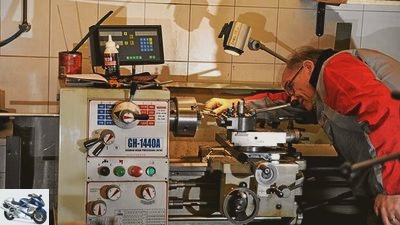
Siemer, Fred
Ferry the mechanic.
Ferry Brouwer left the Grand Prix circuit, became workshop manager of a new, rapidly growing motorcycle shop, married his Margriet, whom he had met at Yamaha in Amsterdam, and remained connected to the sport: he built a cross for his boss, Ton van Heugten – Team with 830 cm³ inflated XS 650 engine and led the company’s own racing team.
So Tanaka San didn’t have to look far when he needed a technician for a daring idea in 1974: three-cylinder engines were to compete under the direction of Yamaha Europa. The template was provided by the enthusiastic team driver Rudi Kurth, who had coupled a TD3 twin with another cylinder and also built the crankshaft from Yamaha parts. Ferry found the matter exciting, but not only as a 500: “You could also build a 350 with 250 parts.” And so it happened. In 1976 a Hoeckle crankshaft improved the engine, Kent Andersson became team manager in 1977, the drivers were Giacomo Agostini and Takazumi Katayama. “Three great guys. Kent was my friend, but he was into steel. He reacted really suspiciously to titanium or magnesium, and so in the end our 350 weighed more than the 500, Ago found it horrible and soon no longer wanted to drive it. Takazumi was a rider with the highest technical instinct, he got along really well and helped us a lot with development. ”At the end of 1977 Katayama became the first Japanese world champion.
Continuation of the success story: the entry into the helmet market
Light is often followed by shadow, as someone who grew up among little people in a poorer district of The Hague knows. Daughter Naomi was just two when Ferry became unemployed.
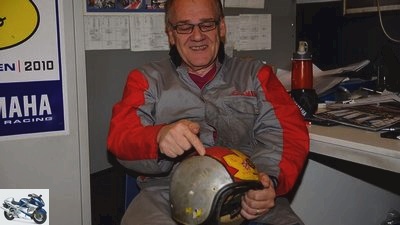
Siemer, Fred
Ferry shows us the helmet he had on his head in an accident.
But Ferry is wide awake. Wherever he goes, he learns. His father was his teacher: “You have two ears to hear, two eyes to see, a mouth to ask.” He can work systematically: the helmet market offered opportunities. He can convince: there was a brand whose logo he liked and which wasn’t really represented in Europe yet. Ferry got the contract, and what followed would be a great story for a business magazine, because the mechanic Brouwer quickly established Arai as one of the few helmet brands in the high-price segment, not least by having almost the entire prominence of two- and four-wheel racing drivers as satisfied advertising media took advantage of. Ferry became wealthy, worked a lot and sometimes too much, and was ultimately responsible for imports into 47 countries. In 2008, after 25 years, he sold.
What does the time with Arai mean?
“Learn a lot and – also for Margriet – work a lot. I acted like a race: where am I better than my opponents, where can I overtake them? Still a huge change. At first I was in the paddock with my racing service and talked to drivers. But I had nothing more to do with their motorcycles. “
That’s why you started restoring motorcycles?
“No, it has to do with my father. Like my friend Minoru Tanaka, he had died in 1990. And an acquaintance from The Hague had – for whatever reason – kept a Puch moped for him. He gave it to me and said: Here, take your inheritance. While I had this little Puch in the workshop, I was very close to my father and all these years with him, and I understood why he restored motorcycles. Not because he wanted to turn back the clock, but to keep the memory alive. “
And that’s what you wanted to do: get memories?
“Not immediately. When I hosted Centennial in 1998, I really thought we could bring back the good old days. Perfect motorcycles, masses of spectators, great atmosphere. And then many of my beloved heroes came into the paddock with a set on their belly and a bald head. It became clear to me that we can only preserve memories. “
Your fondest memories have to do with Yamaha, right??
“Always with my family. And the best thing about Yamaha is that I met Margriet there, I owe her a lot. But I know what you mean: I was very close in a very successful time, okay. Still, I only limited myself to Yamahas on my racing team because I understand these motorcycles best. I know your soul. That’s why everyone now thinks as a matter of course that my dream motorcycle must be a Yamaha. Nobody asks me about it. “
Oh damn. Ferry, what is your dream motorcycle actually?
“The Zundapp GS 125. In the factory trim, of course, with an Amal carburetor and six-speed gearbox.”
Ferry would be thrilled to see this dream come true. Show everyone that he’s not committed to street racers. That his curiosity continues to burn. And he still has questions.
Related articles
-
Scene: Portrait of two-stroke fan Scherubl
Siemer 15th pictures Siemer 1/15 The two-stroke fan Gunter Scheruebl transforms old series motorcycles into racing replicas. Siemer 2/15 Scherubl can…
-
Scene – workshop portrait Zweirad Wiebusch
Thomas Schmieder 10 pictures Thomas Schmieder 1/10 Picture gallery: Workshop portrait Zweirad Wiebusch. Thomas Schmieder 2/10 Marco Wiebusch is all about…
-
Report: Portrait of the Ducati works driver Cal Crutchlow
Wood 11 pictures Gold and Goose Photography 1/11 Someone like Cal Crutchlow spends the whole year flying around the world in business class, puts a…
-
Scene: Retro Guzzi in a company portrait
Thomas Schmieder counselor traffic & business Scene: Retro Guzzi in a company portrait Scene: Retro Guzzi in a company portrait Passione, Amore &…
-
Portrait of US collector Fred Mork
Blacksmith 27 pictures Blacksmith 1/27 The similarity between human and … Blacksmith 2/27 Blacksmith 3/27 Tons of story (s): whether model kits,…
-
Sports report: A portrait of the ice speedway driver Gunther Bauer
wolf Sports & scene Sports report: A portrait of the ice speedway driver Gunther Bauer Sports report: Ice Speedway A portrait of the ice speedway driver…
-
MotoGP – Dorna boss Carmelo Ezpeleta in portrait
2snap Sports & scene Motorsport MotoGP – Dorna boss Carmelo Ezpeleta in portrait MotoGP – Dorna boss Carmelo Ezpeleta in portrait The show master Excited…
-
Osterling 11 pictures Osterling 1/11 Kurt Schupp’s Vincent collection includes a number of wonderfully preserved specimens. Osterling 2/11 Also a perch…
-
Mick Doohan and Casey Stoner in portrait
2snap Sports & scene Mick Doohan and Casey Stoner in portrait Portrait: Comparison Mick Doohan / Casey Stoner The MotoGP riders from Australia Content of…
-
Portrait of designer Uwe Schneider
Siemer 27 pictures Siemer 1/27 Siemer 2/27 Siemer 3/27 Siemer 4/27 Siemer 5/27 The engine and transmission were specifically and very successfully…